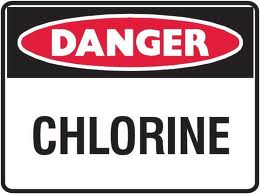Chlorine is used to disinfect municipal water supplies and swimming pools from harmful bacteria. But chlorine is also a highly toxic element, which has an ability to oxidize all proteins, effectively rendering them useless. All living organisms are made up of proteins. Hence, any living organism that comes in contact with even trace amounts of chlorine is affected and, if exposed to sufficient quantities of chlorine, killed.
Some of nature’s most valuable and essential anti-cancer and anti-disease phytochemical nutrients, which are commonly found in food, have been discovered to form deadly cancer causing substances when consumed or combined with chlorinated tap water. This discovery includes familiar foods including soy, fruits, vegetables, tea, many health products, and some prescriptions.
The major health issue regarding the chlorination of municipal water is that it exposes us to a variety of toxic chemicals called trihalomethanes (THMs), which are byproducts of chlorination. Studies have linked THMs to miscarriage and fetal malformations, and they may be also associated with an increased risk of stillbirths.
One of the most common of the THMs, chloroform, is classed as a potential cancer-causing agent. In public pools it has been measured at more than twenty times the level found in tap water. Little data exists regarding dermal and inhalation exposure routes to the chloroform body-burden from domestic and recreational use of chlorinated water.
A joint study was undertaken in Japan by research scientists at the National Institute of Health Sciences and Shizuoka Prefectural University. They determined that natural organic substances react when exposed to chlorinated tap water, forming dangerous cancer causing compounds named MX, which stands for “Unknown Mutagen”. They are similar to cancer causing THMs (trihalomethanes).
It is certain that the fresh plant foods we eat similarly react with the chlorinated tap water we drink with our meals, creating toxins. This means that fresh fruits and vegetables, green salads, green tea, black tea, herb teas, soy products, vitamins and various health supplements, and even some pharmaceutical drugs all can be implicated in combination with chlorinated water.
Although Chlorine has essentially eliminated the risks of waterborne diseases such as typhoid fever, cholera and dysentery, there are many pathogens that are not controlled by chlorine. The bacteria Cryptosporidium parvum, excreted in the feces of infected humans, cattle, and other mammals, is highly resistant to chlorine at the levels normally found in swimming pools and drinking water. Giardia lamblia is also more resistant to disinfection by chlorine, but can be effectively filtered.
How Safe is Showering?
Volatile chemicals like THMs can evaporate from water in a shower or bath. Conservative calculations indicate that inhalation exposures can be as significant as exposure from drinking the water; that is, one can be exposed to the same amount of THMs by inhaling during a shower as by drinking two litres of water a day. People who shower frequently could be exposed through ingestion, inhalation, and/or dermal absorption.
Some studies found that the dangers from inhaling chlorine can even exceed those derived from drinking chlorinated water. The amount of chloroform, the most common trihalomethane in chlorinated water, inhaled or absorbed through the skin during a typical shower may be six times higher than that absorbed from chlorinated drinking water.
The Cancer Connection
Epidemiological studies funded by Health Canada concluded that 14 to 16 percent of bladder cancers in Ontario may be attributable to drinking water containing relatively high levels of chlorination byproducts. According to the results of a 1992 Norwegian study published in theInternational Journal of Epidemiology, the consumption of chlorinated drinking water has been associated with a 20- to 40-percent increase in the incidence of colon and rectal cancer.
A study done by the Medical College of Wisconsin and Harvard University found that the consumption of chlorinated drinking water accounts for nearly 15 percent of all rectal cancers and nine percent of all bladder cancers in North America. The study also concluded that drinking chlorinated water over long periods of time increases the chances of contracting rectal cancer by 38 percent and contracting bladder cancer by 21 percent. In addition, among those who drank chlorinated water, the researchers found a higher incidence of cancer of the esophagus, rectum, breast, and larynx, as well as Hodgkin’s disease.
Alternatives to Chlorination
A healthier alternative in the treatment of drinking water is the use of ozone sterilization.
The first water treatment plant to use ozone for disinfection was installed in Ousbaden, Holland, in 1893. Today, after 110 years of usage, ozone sterilization is utilized in countries throughout the world including Germany, France, the US, Cuba, Japan, and Mexico.
Internet Resources:
http://www.relfe.com/A06/drinking_water_treatment_chlorine.html
http://www.alive.com/articles/view/18356/chlorinated_drinking_water

